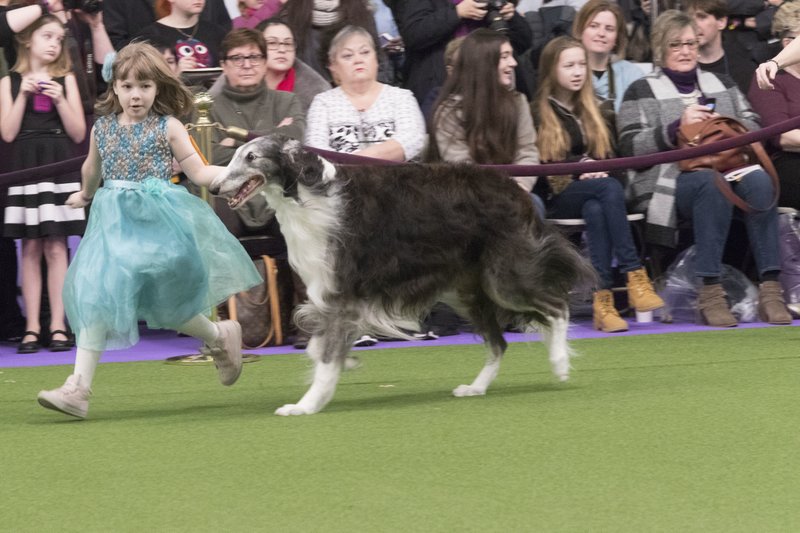
In this Feb. 13, 2017, file photo, Raina McCloskey, from Delta, Pa., shows Briar, a borzoi, during the 141st Westminster Kennel Club Dog Show in New York. The Westminster Kennel Club competition is best known for the dog crowned Best in Show, but it’s also a showcase for young handlers who sometimes go up against grown-ups. (AP Photo/Mary Altaffer, File)
NEW YORK — Fenric Towell isn’t nervous about his first time competing at the nation’s top dog show. After all, he’s heading to the Westminster Kennel Club ring this week with 100-plus shows under his belt, a record of wins and a champion Lakeland terrier.
So what if he’s only 11?
“I’m going to try to think of it as a normal show,” the Oklahoma City boy says. “I just try to focus on the highest place that I can get.”
Westminster is best known for the dog that will be crowned best in show Tuesday night at Madison Square Garden. As judging began Monday night, a borzoi named Lucy won the hound group, a pug dubbed Biggie won the toy group and a bichon frise called Flynn took the nonsporting group. Slick, a border collie, won the herding group.
But the event is also a showcase for youngsters who can handle both dogs and grown-up competition.
While there’s a special contest for junior handlers, many also exhibit their dogs in the breed judging that goes toward best in show. They go up against adults in an atmosphere that prizes poise and formality.
“It’s hard because they’re top people, and we’re just kids,” says Faith Rogers, 14, of Bordentown, New Jersey, now at her fourth Westminster. But when she started showing dogs at age 9, she decided: “This is what I love, and I didn’t really care if there were older people or not.”
Or, as twin sister Emma puts it, “Let’s just show ’em what we got.”
Dogs ranging from wee Chihuahuas to rangy Irish wolfhounds showed what they’ve got in Monday night’s group judging, helped by adult handlers.
Lucy “knows when there’s a big stage,” said handler Valerie Nunes-Atkinson. Handlers, meanwhile, need to “go Zen” so their dogs won’t pick up jitters, Bill McFadden said after leading Flynn.
Slick has won best of breed previously at Westminster, but Monday’s herding group win “means a lot to us,” handler Jamie Clute said.
Biggie’s handler, Esteban Farias, called the dog “a dream come true” after a tragedy: a previous pug pal suddenly died during a routine walk.
About 5,000 junior handlers nationwide are registered with the American Kennel Club, a governing body for Westminster and many other dog shows. Young handlers also can compete through 4-H and other kennel clubs.
AKC “junior showmanship” competitions are open to youngsters ages 9 to 18. They’re judged on their presentation, not their dogs’ particulars.
But there’s no age minimum for handlers in the breed rings, a point driven home to Thanksgiving Day TV watchers who saw (emphasis on the “awwww”) 6-year-old Mackenzie Huston and her long-coat Chihuahua in a semifinal round at the Kennel Club of Philadelphia’s National Dog Show.
Mackenzie sometimes feels scared as she waits to show. But “when I get in the ring, I don’t feel nervous,” says the now 7-year-old girl from Bellmawr, New Jersey.
She isn’t going to Westminster — yet — but super-young handlers have shown there, including then-7-year-old Raina McCloskey last year (with a borzoi, no less.)
Westminster’s 95 junior invitees are “very competitive, they’re very talented and very, very good,” show chairman David Helming said. Westminster is boosting its top juniors’ prize, a scholarship, from $6,000 to $10,000 this year. The eight finalists all get some education money.
Dog showing requires an investment of money and, particularly, time. Junior handlers can spend hours per week training, grooming and exercising their dogs, weekends traveling to shows and years balancing it all with school, other activities and friends.
All that to don dress clothes and notch accomplishments many of their peers can’t quite understand. (“You’re running around in a circle with dogs?“)
But young handlers say it’s worth it for the bond they develop with their animals.
“You go and spend time with your best friend,” says Emma Rogers, who’s returning to Westminster as a 2016 juniors finalist (older sister Sophia won).
Juniors come away with human friends all over the country, plus an education in animal behavior and patient teamwork.
“You have to be very resilient,” says Erin LaPlante, 17, of Caledonia, Wisconsin. “You’re going to lose far more than you’re going to win, but you learn far more than you win.”
About five years after her dog show debut ended in tears, she won juniors at the AKC National Championship in December and is returning to Westminster. So is sister Maren, 13.
Their family had never shown dogs before Erin started, at the suggestion of their Doberman’s breeder. Molly Anne Forsyth, on the other hand, comes from two generations of breeders of greyhound-like Salukis. But “we trust each other even more from showing together,” says the 16-year-old from Davis, California.
For parents, the sport requires acclimating to the occasional double take when a 6-year-old uses the word “bitch” —appropriately, for a female dog — plus a lot of driving and helping out.
“I can dress a little boy in a suit in my sleep,” laughs Alysha Towell. Her daughter and six of her seven sons, including Fenric, either show dogs or soon will.
Cortlund, 17, was a juniors finalist at Westminster last year, earning a turn in the big ring at Madison Square Garden. He placed fourth and is returning this year.
“It’s not like any other sport,” he says. “If you play soccer or football and quit, they can live without you. You can’t quit on a dog.”

